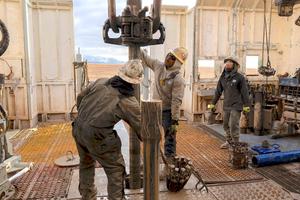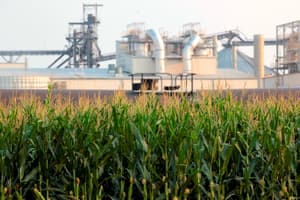The Grand Ethiopian Renaissance Dam is being built on the Ethiopian-Sudanese border on the Blue Nile, which supplies 59 percent of Egypt’s water. Yale Environment 360
The dam will create a reservoir more than twice the size of the Hoover Dam’s Lake Mead, the largest reservoir in the United States. It will ultimately store 74 billion cubic meters of Blue Nile water. (That’s about 64 million acre feet, or the amount of water need to cover 100,000 square miles of land one foot deep.) Filling it could take anywhere from five to 15 years.
“During this period of fill,” a new study in the Geological Society of America’s journal GSA Today reports, “the Nile’s fresh water flow to Egypt may be cut by 25 percent, with a loss of a third of the electricity generated by the Aswan High Dam.” That is of course Egypt’s own massive dam on the Nile, completed in 1965, roughly 1,500 miles downstream. The GSA study, led by Smithsonian Institution geologist Jean-Daniel Stanley, says Egypt faces “serious country-wide freshwater and energy shortage by 2025.” Agriculture in the delta, which produces up to 60 percent of Egypt’s food, could also suffer from shortages of irrigation water.
The GSA study makes clear, moreover, that the new dam is only one of a series of environmental threats now facing Egypt. Rising sea levels, brought on by climate change, are the most obvious of them. Much of the Nile Delta is only a meter or so above sea level, and a 2014 analysis led by Assuit University geologist Ahmed Sefelnasr predicted that a half-meter rise in sea level would shrink the delta by 19 percent, an area equivalent to all of metropolitan Los Angeles. That was the conservative scenario. If the sea level rises by one meter in this century, as many climate scientists think likely, a third of the delta could disappear under the Mediterranean. That analysis did not consider the likely effects of the significantly greater rise predicted by a 2016 study in Nature.
Egypt is already one of the poorest nations in the world in terms of water availability per capita.
It also ignored the compounding effect of land subsidence in the delta, particularly along the Mediterranean coast. In an interview, the Smithsonian’s Stanley attributed subsidence there to continuing compaction of underlying geological strata and to seismic activity. “The region is considered tectonically stable,” he said. “But it’s not inactive.” Earthquakes of magnitude 5 or greater occur about every 23 years there, and “earthquake events of shallow origin and small magnitude” are frequent. The delta is also subsiding (and becoming less fertile) because it is no longer replenished each year by 100 million tons by flood sediments from the Nile. Instead, those sediments now drop out where the Nile enters the reservoir created by the Aswan High Dam. A new delta is now forming there, but underwater. Other studies have attributed increased seismic activity in the region to the weight of the dam and the water stored behind it.
In addition to the almost certain loss of land area in the delta, the combination of sea level rise and land subsidence will also increase saltwater intrusion. Egypt is already one of the poorest nations in the world in terms of water availability per capita; it has just 660 cubic meters of freshwater a year for each resident, compared, for instance, to 9,800 cubic meters in the United States. But according to the Sefelnasr study, saltwater intrusion from a one-meter rise in sea level could jeopardize more than a third of the freshwater volume in the delta. “If you talk to farmers in the northern delta,” said Stanley, “they will tell you they have lost production consistently, and that saline wedge is moving toward the middle of the delta. So it doesn’t look like a very happy thing,” especially with Egypt’s population set to double over the next 50 years.
An Egyptian farmer tends fields on the banks of a branch of the Nile in the river's delta. GIANLUIGI GUERCIA/AFP/Getty Images
So how should Egypt, with its struggling economy and recent history of political unrest, address what are plainly life-threatening challenges? Despite the loose talk about destroying the Ethiopian dam, war appears highly unlikely. In 2015, Egypt, Ethiopia, and Sudan signed a mutual do-no-harm agreement, and just this past January, Egyptian President Abdel Fattah el-Sisi met in Addis Ababa, on apparently cordial terms, with Ethiopian Prime Minister Hailemariam Desalegn. But a formal agreement on exactly how to share Nile resources is still lacking.
Ethiopia could minimize the immediate downstream damage by lengthening the time it takes to fill the reservoir. But that means delaying the benefits of the dam, which Ethiopia may already have oversold. The river flow will produce the promised 6,000-megawatt output only during peak periods, according to Asfaw Beyene, a mechanical engineering professor at San Diego State University. He notes that the Italian company building the dam also performed the initial feasibility studies, an obvious conflict of interest because of the potential to inflate costs and profits by installing excess capacity. Beyene calculates that even a 2,000-megawatt rating might have been “a little excessive.”
Pressure to get a return on its investments could make Ethiopia less likely to delay. Egypt in any case has little ground for negotiating a favorable deal, said Harry Verhoeven, a professor of African politics at Georgetown University. It has always asserted its right to the lion’s share of Nile River water, formalizing that claim in the 1959 Nile Waters Agreements, with little regard to the needs of upstream countries. Hosni Mubarak compounded that slight during his long reign as Egypt’s president, taking other Nile Basin countries for granted and effectively withdrawing from the rest of Africa. “In that sense, it’s hard to feel sorry for Egypt,” said Verhoefen.
Ethiopia has rebuilt its economy and asserted control over Nile waters that are the region’s lifeblood.
Meanwhile, “as Egypt slept,” an “extremely competent” government in Ethiopia has rebuilt its economy, deftly worked with both U.S. and Chinese interests, and launched what Verhoeven characterized as “a hydropolitical offensive to re-order the region,” not just in political or theoretical terms, but on the ground, by asserting control over the Nile waters that are the region’s lifeblood. The United States could perhaps serve as an honest broker to negotiate a compromise between Egypt and Ethiopia. It has until recently played an important role working behind the scenes with both Cairo and Addis Ababa (a key ally on conflicts in Somalia and South Sudan). But under President Trump, said Verhoeven, both the National Security Council and the U.S. State Department have demonstrated little interest in Africa.
At this point, said the Smithsonian’s Stanley, Egypt needs to invest in desalinization for fresh water, like Saudi Arabia, and water-saving drip irrigation, like Israel. With Egypt now also facing a “contraceptive crisis,” better government investment in family planning would also help for the longer term. But with the Nile no longer their birthright, and the Nile delta gradually disappearing into the sea, millions of Egypt’s people will inevitably need to look elsewhere for a livable future.





